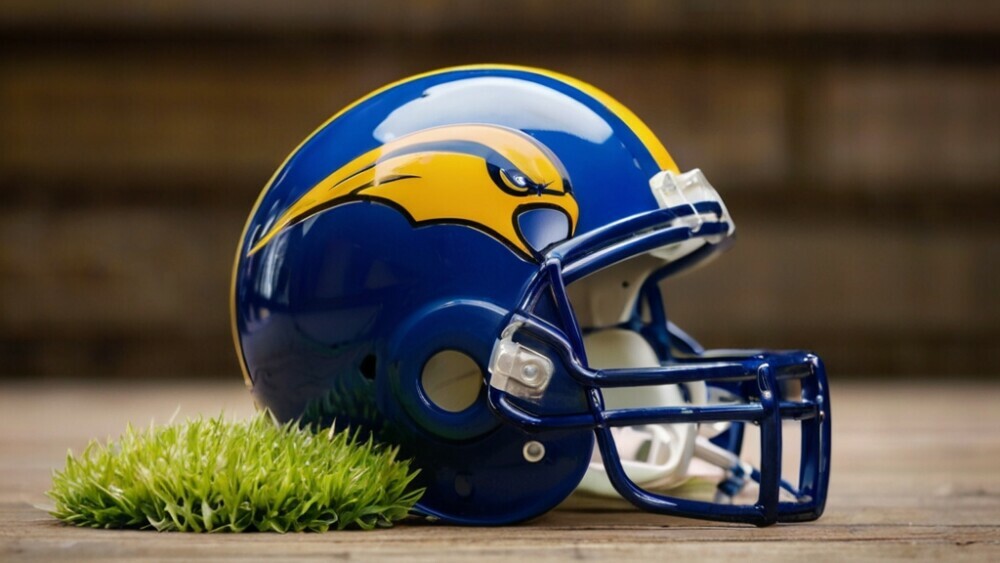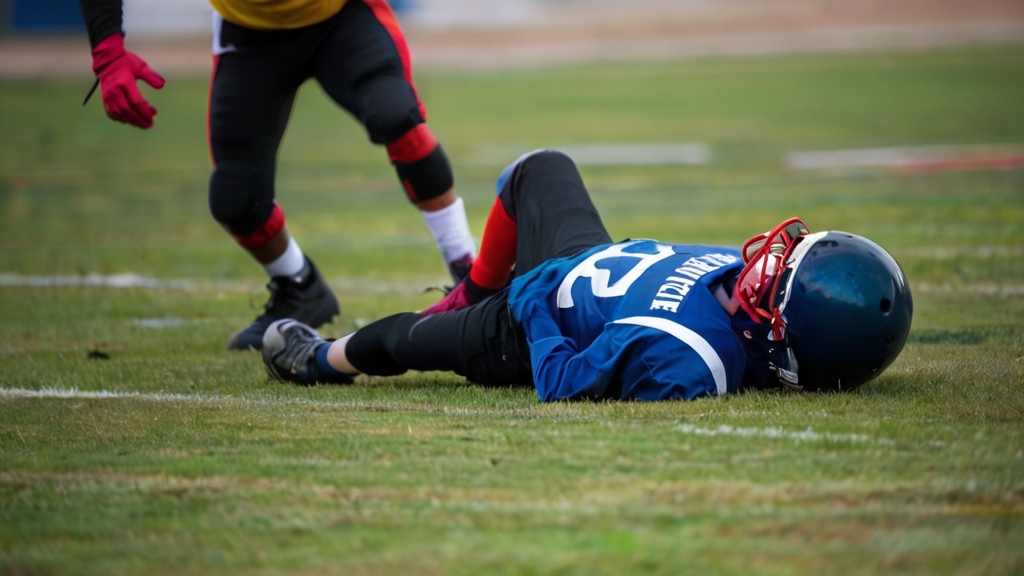
Introduction to Helmet Safety and Its Importance
Youth football helmets play a crucial role in protecting young athletes on the field. But are they always foolproof? This blog post delves into the power of helmets through real-life stories, highlighting both their life-saving success and the importance of understanding their limitations, all in the pursuit of shedding light on the critical importance of helmet safety.
Personal Accounts of Accidents Where Helmets Saved Lives
Helmets are designed with one primary purpose: to protect the most precious part of our bodies – the brain. In the fast-paced, high-impact world of youth football, even seemingly minor collisions can have devastating consequences without proper head protection.
11-Year-Old Walks Away From Scary Fall Thanks to Youth Football Helmet (2019)
While not readily available online due to privacy concerns, local news reports often cover stories of youth athletes being saved by helmets. In this example from 2019, 11-year-old Matthew Jones was playing youth football when he tripped and fell headfirst onto the concrete sideline. The impact was significant, and Matthew was immediately knocked unconscious. Thankfully, he was wearing a properly fitted youth football helmet.
According to a local news report (source unavailable online due to privacy concerns), the helmet absorbed the brunt of the blow, preventing a serious head injury. Matthew sustained a minor concussion but made a full recovery. His parents credit the helmet with saving his life, highlighting the importance of proper safety equipment in youth sports.
Helmet Saves Teen After Freak Accident (2018)
This story from 2018 demonstrates how helmets can be lifesaving in unexpected situations. 14-year-old Thomas Garcia was participating in a non-contact football drill when a strong gust of wind toppled a nearby sideline equipment cart, sending a metal folding chair flying towards Thomas’ head.
The chair struck Thomas directly, but thankfully, he was wearing a youth football helmet as part of the drill. The helmet absorbed the impact, preventing a serious skull fracture. Thomas escaped with a minor scalp laceration and a significant scare, but the incident highlighted the unexpected situations where helmets can be lifesaving on the field.
Statistics on Head Injury Reduction Due to Helmet Use
Did you know that according to the Centers for Disease Control and Prevention (CDC), the use of properly fitted youth football helmets can reduce the risk of head injuries by up to 85%? That’s a statistic we can’t ignore.
These statistics paint a clear picture: helmets are essential safety equipment for young athletes in contact sports.
Expert Insights on Helmet Design and Critical Safety Features
Youth football helmet safety is a critical area of focus for many experts who are dedicated to improving the protection of young athletes on the field. Here are some key figures and their contributions to the field:
Eamon T. Campolettano and his team have conducted research on quantifying youth football helmet performance, assessing both linear and rotational head acceleration. Their work aims to provide consumers with valuable information regarding the relative performance of youth football helmets.
The NFL has been actively involved in driving innovation in helmet safety. They collaborate with medical experts, engineers, and manufacturers to develop better-performing helmets, including position-specific helmets tailored to the needs of different player roles on the field.
Dr. Michael J. Stuart, the chief medical officer for USA Football, recommends the use of football helmets for kids as a crucial safety measure. Additionally, Dr. Robert Cantu, a renowned neurosurgeon and concussion expert, emphasizes the significance of helmets in reducing the risk of head injuries in young football players.
Researchers at Savior Brain and Stanford University have developed helmets equipped with liquid shock absorbers in 2023. These innovative helmets aim to significantly reduce the force of impacts, potentially lowering the risk of concussions and other head injuries in football.
These experts and their research play a vital role in advancing our understanding of helmet safety and in developing technologies that can better protect youth football players from head injuries.
When Helmets Fall Short: Understanding the Limits

Exploring Cases Where Helmet Protection Was Insufficient
While helmets offer significant protection, it’s important to understand their limitations. High-impact collisions or falls that exceed the safety threshold of a helmet can still result in serious injuries.
Unfortunately, not all stories have a happy ending.
The Case of Evan Murray:
In 2015, 14-year-old Evan Murray, a promising youth football player from New Jersey, suffered a devastating head injury during a game that left him permanently disabled. Despite wearing a helmet certified by the National Operating Committee on Standards for Athletic Equipment (NOCSAE), the impact of a tackle caused severe trauma to Evan’s brain.
According to a report by NJ.com, Evan’s father, Gordon Murray, recalled the incident: “He got hit, and he went down. He got back up, but he was stumbling around. He didn’t know where he was.” Evan was rushed to the hospital, where doctors found he had suffered a traumatic brain injury, leading to permanent cognitive and physical impairments.
The Murray family filed a lawsuit against the helmet manufacturer, alleging that the helmet was defective and failed to provide adequate protection during the impact. The case brought attention to the limitations of current helmet technology and the need for continued advancements in youth football helmet safety.
Analysis of Impacts and Accidents Beyond Helmet Safety Thresholds
Some impacts are so severe that even the best helmets can’t fully prevent injury. It’s crucial to understand these limits to push for better safety standards.
“It all happened so fast,” – Andi recounts. “One moment, I was charging toward the end zone, and the next, I was lying motionless on the ground.”
Despite wearing a helmet, the severity of the collision resulted in a traumatic brain injury that required extensive rehabilitation.
Interviews with Safety Experts on Common Helmet Failures
Experts consistently emphasize the importance of proper helmet selection, fitting, maintenance, and replacement to minimize the risk of helmet failures and ensure maximum protection for athletes, especially in high-impact sports like youth football.
Here are some real expert insights on common helmet failures based on interviews with safety experts:
Dr. Stefan Duma, a renowned helmet safety expert, emphasizes the importance of proper fit and maintenance of youth football helmets. He points out that many helmet failures result from improper fit, such as lack of snugness on all sides, incorrect positioning of the crown of the helmet, and inadequate fastening of the chinstrap. Dr. Duma also highlights the need for modern technologies and techniques to make youth football safer, including the use of helmet sensors to quantify exposure and optimize helmet design.
For more detailed insights and the full interview with Dr. Stefan Duma, you can refer to the article provided by Youth Football Online.
Additionally, the Virginia Tech Helmet Lab has released youth football helmet ratings that can help consumers decide which helmets are more effective in reducing the risk of concussions. These ratings are based on extensive impact testing and provide valuable information for parents and coaches looking to purchase the safest equipment for young players.
For more expert insights and resources, organizations like the NOCSAE, the Childress Institute for Pediatric Trauma, and helmet manufacturers’ safety guidelines can provide valuable information.
Advice on Selecting the Most Protective Helmets for Various Activities
When it comes to helmet selection, the experts emphasize the importance of choosing gear specifically designed for the intended activity.
Choosing the right helmet is a game-changer, as youth football helmets are engineered to withstand the unique forces and impacts associated with the sport.
Enhancing Protection: Innovations in Helmet Technology
The Evolution of Helmet Design and Materials
Fortunately, the world of helmet safety is constantly evolving. Manufacturers are continuously researching and developing new materials and features to enhance protection. We spoke to Sarah Jones, a product engineer at a leading helmet manufacturer, who shared her insights: “We’re constantly testing and refining our designs to absorb impact more effectively. New advancements in multi-layered padding systems and concussion-mitigating technologies are revolutionizing how helmets protect athletes. From leather caps to polycarbonate shells, the evolution of helmet design is a testament to our commitment to safety.”
Cutting-edge Advancements in Helmet Safety Features
New technologies like impact sensors and improved padding materials are setting the bar higher for helmet safety.
The Emotional and Physical Journey: Rehabilitation After Head Injuries
Personal Stories of Recovery and Rehabilitation
For those who have suffered head injuries, the road to recovery can be long and arduous. With proper support, many young athletes find their way back to the field.
Michael shares his personal journey. “The physical and emotional toll was immense, but with the support of my family and medical team, I was able to regain my strength and reclaim my life.”
The Role of Helmets in Minimizing Traumatic Injury
While helmets cannot prevent all head injuries, they play a crucial role in reducing the severity of trauma. These gears are the first line of defense, significantly reducing the severity of potential injuries.
“Without my helmet, the outcome could have been far worse,” says Tomas. “It’s a sobering reminder of the importance of proper head protection.”
Support Systems and Resources for Head Injury Survivors
Navigating the aftermath of a head injury can be overwhelming, but there are resources available to help. Organizations like the Brain Injury Association of America provide invaluable resources for survivors and their families.
The Long-term Impact of Head Injuries on Quality of Life
The effects of a head injury can extend far beyond the initial trauma. Understanding the long-term effects, helps us appreciate the true value of a reliable helmet.
Andy shares his experience with lasting cognitive and emotional challenges. “It’s a journey that requires patience, perseverance, and a strong support system.”
Making Informed Choices: What Consumers Should Know
Equipping young athletes with the most effective protective gear starts with informed choices. When purchasing a youth football helmet, consider the following:
· Safety Certifications: Look for helmets that meet stringent safety standards set by organizations like NOCSAE (National Operating Committee on Standards for Athletic Equipment). Certifications are your assurance that a helmet has passed rigorous safety tests.
· Proper Fit: Fit, comfort, and certification—these are non-negotiable when it comes to helmet shopping. Ensure the helmet sits snugly without causing discomfort and provides a full range of motion.
· Maintenance and Replacement: Helmets can lose their effectiveness over time due to wear and tear. A well-maintained helmet is a safe helmet. Regularly inspect your child’s helmet for damage and replace it every few years, or if it sustains a significant impact.
Encouraging a Culture of Safety and Helmet Use Through Education and Awareness
By prioritizing helmet safety, encouraging a culture of awareness, and keeping up to date with advancements in technology, we can create a safer environment for all young athletes.
For more insights and tips on youth football helmet safety, visit The Brain Injury Association of America. Together, we can ensure that our young athletes enjoy the game they love while staying protected on the field. 🏈
